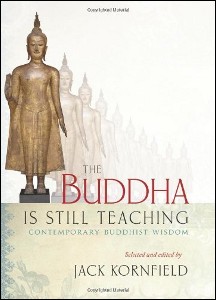|
by William Noseworthy

Jack Kornfield, translator and editor, The Buddha is Still Teaching: Contemporary Buddhist Wisdom, Shambhala Press, 2010. 304 pgs. With The Buddha is Still Teaching: Contemporary Buddhist Wisdom, Jack Kornfield adds yet another volume to the ever growing library of Socially Engaged Buddhism. Tying East to West with contributors ranging from the venerable Thich Nhat Hanh to Ram Dass, from the Dalai Llama to Sylvia Boorstein, from Ajarn Chah to Jack himself, this volume promises to be another inspiring addition to a body of works that professes the increasing relevance of the study of Buddhism for a connected global community. With a spectrum of short meditations, the works of these authors pull together to form a wider narrative of a community stretching beyond the borders of nation and ideology into the realm of pure mind. The book is organized into four sections by topic; however, certain themes permeate throughout the collection: the ease of access to non-formalized students of Buddhism, the relevance to educators and the greater contribution to the literary community. Practically, this volume is hardly appropriate for students who wish to approach Buddhist studies with a rigorously scientific understanding of Sankskrit, Pali and scripture. Instead, its pages, set here to unfold gracefully before readers, suggest that such study is one of the most arduous temptations for students and should not necessarily be undertaken by all practitioners. Rather the ultimate practice of detachment and "letting go" emanates from the center of the text. Thus, achievement is no longer necessary, though it brings certain earthly rewards, and students are reassured that for many, perhaps even for most students of Buddhism, the practice of obsessing over the academic realm of study is fruitless. It becomes more important to simply engage in one's own journey of self-discovery, to fill one's life with right-action, and then to enjoy simple practice: eating, not-thinking, walking meditation and drinking tea with friends. In addition to the advice on practice granted toward non-traditional, or perhaps more lay-students and practitioners of Buddhism, this volume is filled with a series of wondrous, even awe-inspiring narratives that would benefit teachers of all kinds. Even those working in supplementary educational settings might find it befitting, or simply amusing to their students to recount the narrative of Joanna Macy, Cheogyl Rinpoche and the fly who tragically polluted Joanna's cup despite her very nearly monastic character. Other teachers might find the life lessons of endured hardships, such as Thich Nhat Hanh's journey toward the peaceful acceptance of his mother's passing more valuable. By taking these narratives on their own, it is possible for teachers of many levels in both private and public institutions to take this text, and adapt it to any of a variety of classroom experiences. One suggested activity was brought to me by an Art teacher who had worked in middle schools in Brooklyn for years. She had students drawing freely while she read stories from a volume of Buddhist literature. Many of the stories presented in this volume could be used for similar activities, speaking well of their greater contributions to the world of literature. Criticism of such enlightening works of Buddhism is often limited to purists, and divided among those who prefer to focus their study on the absolute text in its primary form and function, those who generally see such works as being too religious and therefore not relevant to the realm of literature and those who fall in between the two camps and are more or less disinterested with the approach of the Socially Engaged movement. Unfortunately, even many practitioners of this movement fail to see works such as The Buddha is Still Teaching on their own, casting aside their ultimate literary value. Yet to see such value one only has to examine the wide variety of experiences drawn into this single volume. Here we begin to see that the experiences of lay-practitioners and esteemed monks are not so different as they engage with the trials and tribulations of their worldly encounters, stretching from the Eastern United States through Colorado to California, from Vietnam through Thailand and Burma to India and again from India through Southern and Northern Africa to Europe before moving back across the Atlantic again. The truth is, as promised in the book, "In these pages you will find the Dharma," and don't worry about the fly in the tea. |